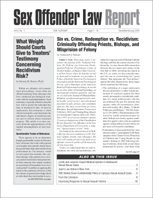Rape and Sexual Coercion: A Social Learning Model
Author: Scot Boeringer.
Source: Volume 02, Number 04, June/July 2001 , pp.49-59(11)

next article > |return to table of contents
Abstract:
Behavioral and social sciences researchers have studied various models of human behavior in an effort to explain the tendencies for rape and sexual coercion exhibited by some individuals and to develop a reliable indicator of the potential for such behavior. In the first part of this article, presented in the last issue of SLR, “Rape and Sexual Coercion: A Social Learning Model,” the author surveyed some of the literature related to sexual coercion and rape. In Part II, presented below, the author reports on one study that examined the following three behavioral models that attempt to predict sexual aggression: 1. social Learning Model; 2. Social Bonding Model; and 3. Relative Deprivation Model. According to social learning theory, individuals adopt behaviors according to how they have been conditioned by experience and reinforcement. If an action results in a reward—e.g., social, such as praise; or nonsocial, such as pleasurable sensations, food, etc.—then that action is likely to be repeated. Also, an action that is observed in others might be initiated if it is seen as rewarding. For example, one may learn to use drugs from watching others experience ostensibly pleasant reactions from drug use. One might learn to sell drugs if one observes drug dealers making money and wielding social power without serious apparent risk of arrest, injury, etc.Keywords:
Affiliations:
1: University of Central Florida.